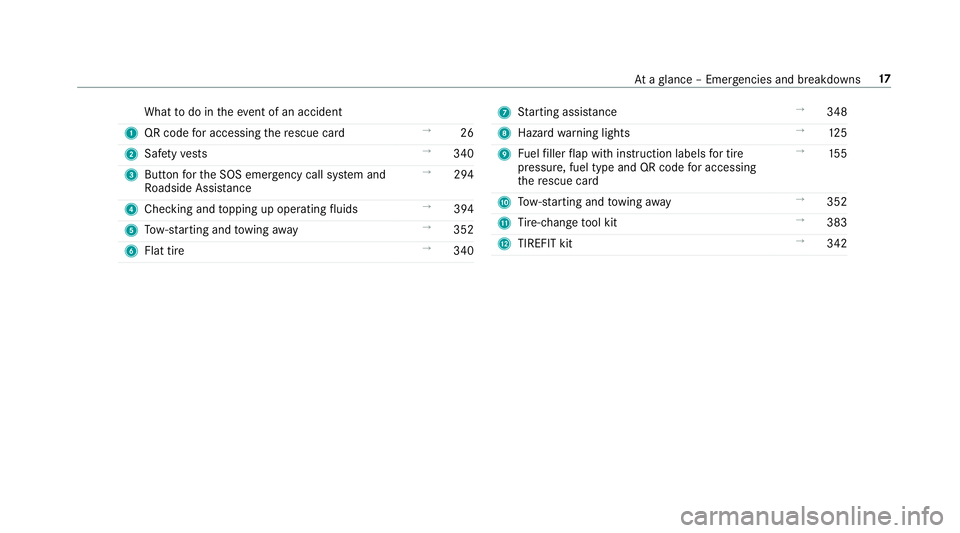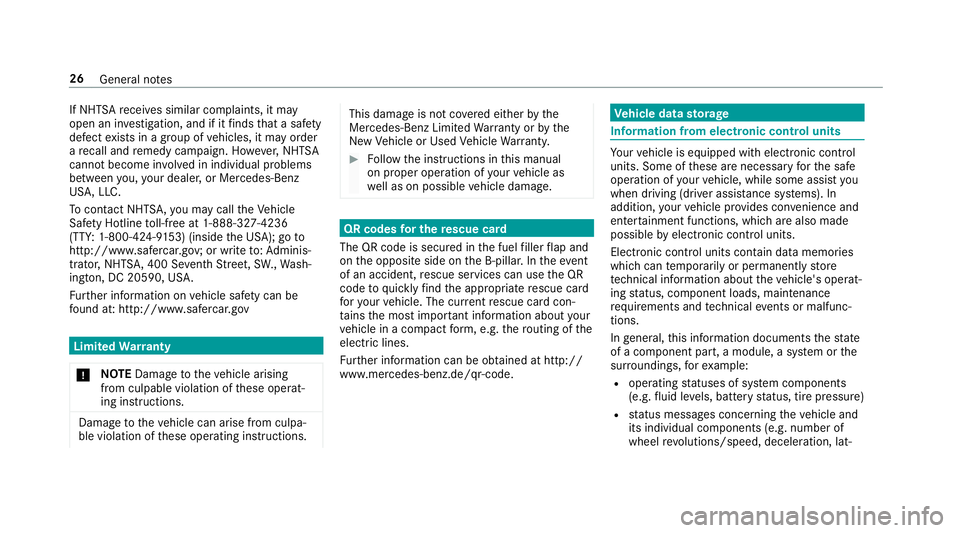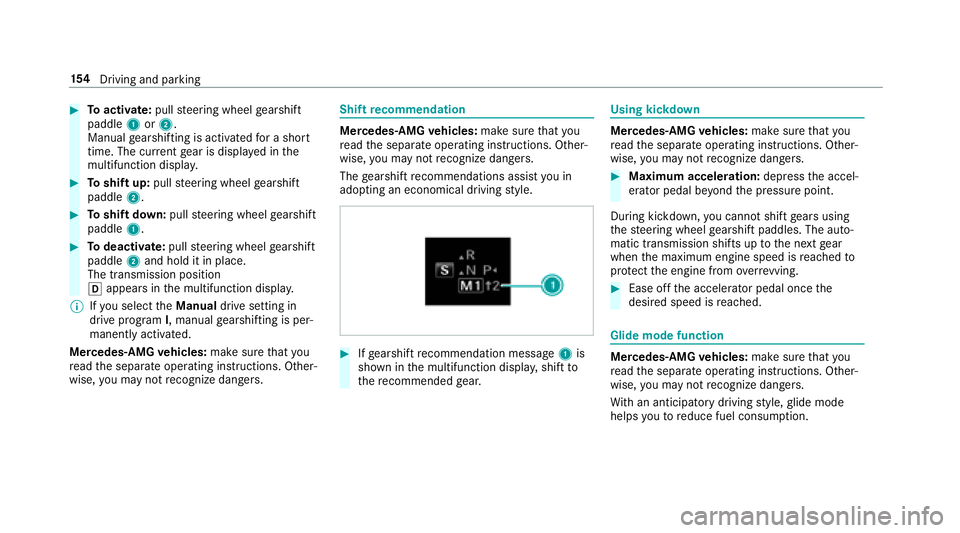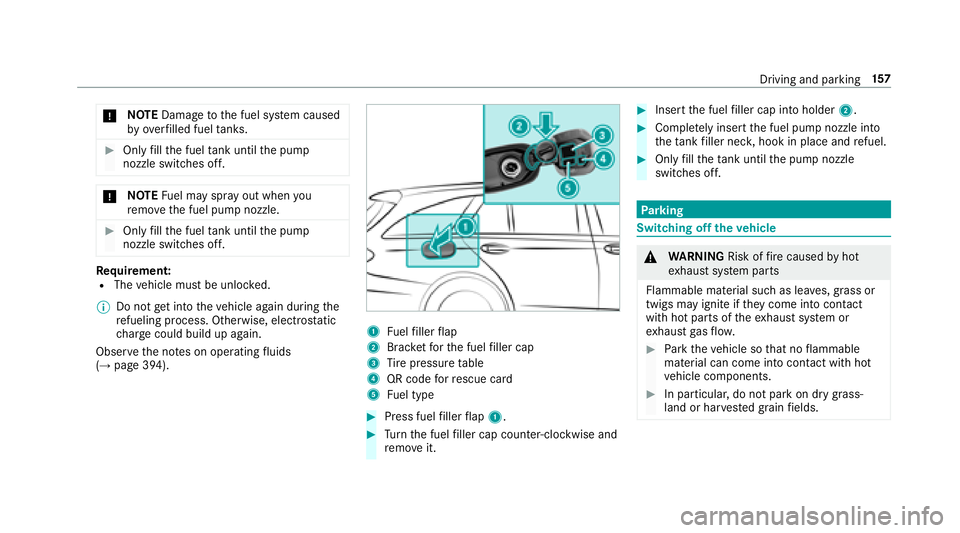2018 MERCEDES-BENZ E-CLASS WAGON fuel pressure
[x] Cancel search: fuel pressurePage 5 of 506

Drivingand pa rking ................................. 143
Driving ........................................................ 143
DY NA MIC SELECT switch ........................... 150
Au tomatic transmission .............................. 151
Re fueling .................................................... 155
Pa rking ...................................................... .157
Driving and driving safe ty systems ............ .166
Instrument Display and on-board
comp uter ................................................... 215
Instrument display overview ...................... .215
Overview of the buttons on thesteering
wheel ......................................................... .216
Operating the on-board computer ............... 216
Displ ays in the multifunction display ........... 218
Ad justing the instrument lighting ............... .218
Menus and submenus ................................. 219
Head-up Display ......................................... 225
Vo ice Control Sy stem .............................. 227
Operating saf ety........................................ .227
Operation ................................................... 227
Using Voice Cont rol Sy stem ef fectively ...... 229
Essential voice commands ........................ .229
Multimedia sy stem .................................. 239
Overview and operation .............................. 239
Sy stem settings .......................................... 247
Na vigation .................................................. 258
Te lephone .................................................. .281
Online and Internet functions ..................... 297
Media ......................................................... 304
Ra dio .......................................................... .316
Sound ......................................................... 323
Main tenance and care ............................. 326
ASS YST PLUS service inter val display ........ 326
Engine compartment .................................. 327
Cleaning and care ...................................... .333
Breakdown assist ance............................ 340
Emergency .................................................. 340
Flat tire ....................................................... 340
Battery (vehicle) ......................................... 346
To w starting or towing away ........................ 351
Electrical fuses ........................................... 356
Wheels and tires ...................................... 360
Noise or unusual handling characteris‐
tics ............................................................ .360
Che cking wheels and tires regularly ........... 360
No tes on snow chains ................................ .361
Ti re pressure .............................................. .361
Loading theve hicle .....................................3 67
Ti re labeling ................................................ 372
Definition of term sfo r tires and loading ..... 377
Changing a wheel ...................................... .380
Tech nical data .......................................... 390
No tes on tech nical da ta.............................. 390
Ve hicle electronics .....................................3 90
Ve hicle identification plate, VIN and
engine number ...........................................3 92
Operating fluids .......................................... 394
Ve hicle data ................................................ 400
Display messages and warning/indi‐
cator lamps .............................................. 402
Display messages ...................................... .402
Wa rning and indicator lamps ...................... 449
Conte nts 3
Page 11 of 506

1Speedom eter →
215
2 ÷ ESP
®→
451
3 #! Turn signal light →
124
4 Ð Steering assis tance malfunction →
461
5 Multifunction displ ay →
218
6 ! ABS malfunction →
451
7 ; Check Engine →
462
8 Tach ome ter →
215
9 % This indicator lamp has no function
A Elect ric park ing brake applied (red) →
451
F USA only
! Canada only
B Brakes (red) →
451
$ USA only
J Canada only
C # Electrical malfunction →
462
D· Distance warning →
460
E ? Coolant too hot/cold →
462
F Coolant temp erature display →
215
G J Brakes (yell ow) →
451
H ! Electric parking brake (yellow )→
451
I 6 Restra int sy stem
J ü Seat belt is not fastened →
459
K T Parking lights →
123
L Fuel le vel indicator
8 Fuelreser vewith fuel filler flap location
indicator →
462
M K High beam →
124
N L Low beam →
123
O R Rear fog light →
124
P AIR BODY CONTROL malfunctioning
Q h Tire pressure monitoring sy stem →
466
R å ESP
®OFF →
451
Ataglance – Warning and indicator lamps 9
Page 13 of 506

1Speedom eter →
215
2 AIR BODY CONTROL malfunctioning
3 #! Turn signal light →
124
4 Multifunction display →
218
5 Tach ome ter →
215
6 å ESP
®OFF →
451
÷ ESP
®→
451
7 K High beam →
124
L Low beam →
123
T Parking lights →
123
8 ? Coolant too hot/cold →
462
9 Coolant temp erature display →
215
A · Distance warning →
460
B Ð Steering assis tance malfunction →
461
C # Electrical malfunction →
462
D Brakes (red) →
451
$USA only
J Canada only
E ü Seat belt is not fastened →
459
F Fuel le vel indicator
G 8 Fuelreser vewith fuel filler flap location
indicator →
462
H R Rear fog light →
124
I 6 Restra int sy stem
J % This indicator lamp has no function
K ; Check Engine →
462
L J Brakes (yellow) →
451
M Elect ric park ing brake applied (red) →
451
F USA only
! Canada only
N h Tire pressure monitoring sy stem →
466
O ! ABS malfunction →
451
P ! Electric park ing brake (yellow) →
451
Ataglance – Warning and indicator lamps 11
Page 19 of 506

Whattodo in theeve nt of an accident
1 QR code for accessing there scue card →
26
2 Safetyve sts →
340
3 Button forth e SOS emer gency call sy stem and
Ro adside Assis tance →
294
4 Checking and topping up operating fluids →
394
5 Tow- starting and towing away →
352
6 Flat tire →
3407Starting assis tance →
348
8 Haza rdwa rning lights →
125
9 Fuelfiller flap with instruction labels for tire
pressure , fuel type and QR code for accessing
th ere scue card →
155
A Tow- starting and towing away →
352
B Tire -change tool kit →
383
C TIREFIT kit →
342
Ataglance – Emer gencies and breakdowns 17
Page 21 of 506

Protecting the environment
+ENVIRONMENTAL NOTEEnvironmental
damage duetooperating conditions and
personal driving style
The pollutant emission of your vehicle is
directly related tothewa yyo u operate your
ve hicle.
Yo u can help toprotect the environment by
operating your vehicle in an environmentally
re sponsible manner. Please obser vethefo l‐
lowing recommendations on ope rating condi‐
tions and pe rsonal driving style.
Operating conditions:
#Make sure that the tire pressure is cor‐
re ct.
#Do not car ryany unnecessary weight
(e.g. roof luggage rack s once you no
longe r need them).
#Ad here tothe service inter vals.
A regularly serviced vehicle will contri b‐
ute toenvironmen tal pr otection.
#Alw ays ha veservice workcar ried out at
a qu alified specialist workshop.
Pe rsonal driving style:
#Do not depress the accelera tor pedal
when starting the engine.
#Do not warm upthe engine while the
ve hicle is stationar y.
#Drive carefully and maintain a suitable
dist ance from theve hicle in front.
#Av oid frequent, sudden acceleration
and braking.
#Change gear in good time and use each
ge ar only uptoÔ of its maximum
engine speed.
#Switch off the engine in stationary traf‐
fi c, e.g. byusing the ECO start/ stop
function.
#Drive in a fuel-ef ficient manne r.
Environmental issues and recommendations:
It is recommended that youre -use or recycle
materials firs t ins tead of just disposing of them. The
releva nt environmental regulations and
guidelines ser vetoprotect the environment and
must be strictly obser ved.
Mercedes-Benz GenuineParts
+ENVIRONMEN TALNO TEEnvironmental
damage causedbynot using recycled
re conditioned components
Daimler AGoffers recycled reconditioned
components and part s withthe same quality
as new parts. The same entitlement from the
Limited Warranty is valid as for new parts.
#Use recycled reconditioned compo‐
nents and part s from Daimler AG.
Gene ral no tes 19
Page 28 of 506

If NHTSAreceive s similar complaints, it may
open an in vestigation, and if it finds that a saf ety
defect exists in a groupof vehicles, it may order
a re call and remedy campaign. Ho wever,NHT SA
cannot become in volved in individual problems
between you, your dealer, or Mercedes-Benz
US A,LLC.
To contact NHT SA,yo u may call theVe hicle
Saf etyHotlin eto ll-f ree at 1-888-327-4236
(TT Y:1-800-424-9 153) (inside the USA); go to
http://www.safercar.gov; or write to:Ad minis‐
trator, NHT SA, 400 Se venth Street,SW .,Wa sh‐
ington, DC 20590, US A.
Fu rther information on vehicle saf etycan be
fo und at: http:/ /www.safercar.g ov
LimitedWarranty
* NO
TEDama getotheve hicle arising
from culpable violation of these operat‐
ing instructions.
Damage totheve hicle can arise from culpa‐
ble violation of these operating instructions.
This damage is not co vered either bythe
Mercedes-Benz Limited Warranty or bythe
New Vehicle or Used Vehicle Warrant y.
#Follow the instructions in this manual
on proper operation of your vehicle as
we ll as on possible vehicle damage.
QR codes for the rescue card
The QR code is secured in the fuel filler flap and
on the opposite side on the B-pillar. In theeve nt
of an accident, rescue services can use the QR
code toquickly find the appropriate rescue card
fo ryo ur vehicle. The cur rent rescue card con‐
ta ins the most impor tant information about your
ve hicle in a compact form , e.g. thero uting of the
electric lines.
Fu rther information can be obtained at http://
www.mercedes-benz.de/qr-code.
Ve hicle data storage
Information from electronic control units
Yo ur vehicle is equipped with electronic contro l
units. Some of these are necessary forth e safe
operation of your vehicle, while some assist you
when driving (driver assis tance sy stems). In
addition, your vehicle pr ovides con venience and
enter tainment functions, which are also made
possible byelectronic control units.
Elect ronic control units contain da tamemories
which cantemp orarily or permanently store
te ch nical information about theve hicle's operat‐
ing status, component loads, mainte nance
re qu irements and tech nical events or malfunc‐
tions.
In general, this information documents thest ate
of a component part, a module, a sy stem or the
sur roundings, forex ample:
Roperating statuses of sy stem components
(e.g. fluid leve ls, battery status, tire pressure)
Rstatus messages concerning theve hicle and
its individual components (e.g. number of
wheel revo lutions/speed, decele ration, lat‐
26
General no tes
Page 156 of 506

#Toactivate: pullsteering wheel gearshift
paddle 1or2.
Manual gearshifting is activated for a short
time. The cur rent gear is displa yed in the
multifunction displa y.
#Toshift up: pullsteering wheel gearshift
paddle 2.
#Toshift down: pullsteering wheel gearshift
paddle 1.
#Todeactivate: pullsteering wheel gearshift
paddle 2and hold it in place.
The transmission position
h appears in the multifunction displa y.
% Ifyo u select theManual drive setting in
drive prog ram I, manual gearshifting is per‐
manent lyactivated.
Mercedes -AMG vehicles: make sure that you
re ad the separate operating instructions. Other‐
wise, you may not recognize dangers.
Shift recommendation
Mercedes -AMG vehicles: make sure that you
re ad the separate operating instructions. Other‐
wise, you may not recognize dangers.
The gearshift recommendations assist you in
adopting an economical driving style.
#If ge arshift recommendation message 1is
shown in the multifunction displa y,shift to
th ere commended gear.
Using kickdow n
Mercedes-AMG vehicles: make sure that you
re ad the separate operating instructions. Other‐
wise, you may not recognize dangers.
#Maximum acceleration: depress the accel‐
erator pedal be yond the pressure point.
During kickdown, you cannot shift gears using
th esteering wheel gearshift paddles. The auto‐
matic transmission shifts up tothe next gear
when the maximum engine speed is reached to
pr otect the engine from overrev ving.
#Ease off the accelera tor pedal once the
desired speed is reached.
Glide mode function
Mercedes -AMG vehicles: make sure that you
re ad the separate operating instructions. Other‐
wise, you may not recognize dangers.
Wi th an anticipatory driving style, glide mode
helps youto reduce fuel consum ption.
15 4
Driving and pa rking
Page 159 of 506

*NO
TEDama getothe fuel sy stem caused
by ove rfilled fuel tanks.
#Only fill th e fuel tank until the pump
nozzle switches off.
* NO
TEFuel may spr ayout when you
re mo vethe fuel pump nozzle.
#Only fill th e fuel tank until the pump
nozzle switches off.
Re quirement:RThe vehicle must be unloc ked.
% Do not get into theve hicle again during the
re fueling process. Otherwise, electros tatic
ch arge could build up again.
Obser vethe no tes on operating fluids
(
→page 394).
1Fu elfiller flap
2Brac ketfo rth e fuel filler cap
3Ti re pressure table
4QR code forre scue card
5Fu el type
#Press fuel filler flap 1.
#Turn the fuel filler cap coun ter-clockwise and
re mo veit.
#Insert the fuel filler cap into holder 2.
#Completely inse rtthe fuel pump nozzle into
th eta nk filler nec k,hook in place and refuel.
#Only fill th eta nk until the pump nozzle
switches off.
Pa rking
Switching off theve hicle
&
WARNING Risk offire caused byhot
ex haust sy stem parts
Flammable material such as lea ves, grass or
twigs may ignite if they come into contact
wi th hot parts of theex haust sy stem or
ex haust gasflow .
#Park theve hicle so that no flammable
material can come into con tact wi thhot
ve hicle components.
#In particular, do not park on dry grass‐
land or har vested grain fields.
Driving and parking 15
7